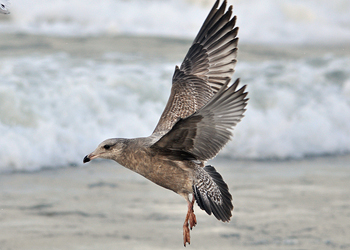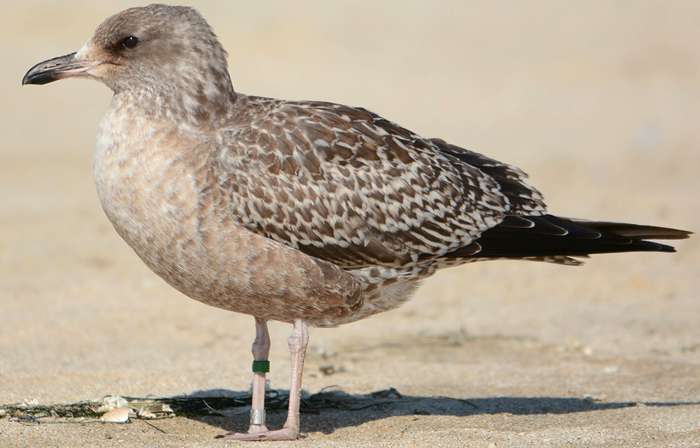 American Herring Gull (smithsonianus)
American Herring Gull (smithsonianus)
(last update: October 30, 2015)
American Herring Gull 4cy March
The Peterson Reference GuidesGULLS OF THE AMERICAS
- Steve N.G. Howell / Jon Dunn -
Below is a copy of chapter 25 about American Herring Gull, illustrated with images from this website. "we" in the text below refers to the original authors. If any errors occur in this text, please let me know and mail to marsmuusseatgmaildotcom.
American Herring Gull (smithsonianus)
PART 1: IDENTIFICATION SUMMARY
PART 2: FIELD IDENTIFICATION - ADULT CYCLE
PART 3: FIELD IDENTIFICATION - FIRST CYCLE (BELOW)
First Cycle.
American Herring Gull is common but notoriously variable, and it should be learned thoroughly. In e. N. America the only other regular dark-winged large gulls are Great Black-backed and rarer Lesser Black-backed. In the West, several potentially similar species occur; also see hybrid American Herring Gull accounts (pp. 482-485 in Gulls of the Americas). Features to note are the relatively long and narrow wings; relatively parallel-sided bill with variable pinkish basally; blackish to brownish black wingtips and tail; and a pale upperwing panel on the inner 5-6 primaries. Relative to other N. Atlantic species, relatively plain brownish underparts of American Herring are distinctive. East Coast types (see Description) average earlier PA1 molt and typically have more solidly blackish tail, whereas West Coast types (see Description) molt later on average and often have whitish at tail base.
THAYER’S GULL averages smaller with a more slender bill that generally has a less distinct gonydeal expansion and often shows slightly steeper and more rounded forehead. Plumage overall slightly to distinctly paler than Herring Gull, blackish brown to medium brown wingtips usually have distinct whitish fringes, upperparts often with coarser and more checkered, or marbled, pale patterning. Inner webs of outer primaries more extensively pale so that pale inner primary panel on upperwing bleeds into distinctly two-tone outer primaries; underside of outer primaries paler, more silvery gray (but can be reflectively pale on Herring). Tail typically dark brown (blackish to blackish brown on Herring). Some darkly pigmented Thayer’s can be very similar to Herring Cull (or hybrids), and problem birds may not be identifiable.
GREAT BLACK-BACKED GULL (e. N. America) larger and more massive overall with more bulbous-tipped bill. Head and underparts whiter and upperparts more boldly checkered; uppertail coverts and tail contrastingly white with clean-cut black distal tail banding; underwings paler brownish overall, contrasting with white body; upperwings rarely with distinct pale panel on inner primaries.
LESSER BLACK-BACKED GULL (widespread but rare in West) averages smaller and slimmer with narrower wings, longer wing projection, and slimmer, all-black bill. Upperparts (including tertials) average narrower pale edgings. Primaries overall dark with no or very indistinct paler panel on inners; bases of greater coverts more often solidly dark brown. Uppertail coverts and tail base contrastingly white with clean-cut, black distal tail band.
CALIFORNIA GULL averages smaller with longer wing projection (tail tip about equal with tip of P6), narrower and more crooked wings in flight, and more parallel-sided bill that, by Oct., is typically flesh pink with a clean-cut black tip (also shown by some Herrings); its pinkish legs often have a bluish hue on the tibia and joints. Primaries overall dark with no or very indistinct paler panel on inners, bases of greater coverts more often solidly dark brown. PA1 molt generally extensive (often includes upperwing coverts) and earlier than Herring Gull.
WESTERN GULL (w. N. America) larger and bulkier with a stouter, rather bulbous-tipped bill, broader wings (often shows a skirt). Dark sooty brownish overall, A1 scapulars typically have blackish centres and grayish to pale brownish edgings (not the barred pattern common on Herring), primaries overall dark with no or very indistinct paler panel on inners, tail solidly blackish; typically does not get whitish-headed look common on first-winter Herring Gull.
VEGA GULL can look very similar (and perhaps not always safely distinguishable) but underparts average paler overall and does not attain strongly bicolored bill. Tail coverts and tail base whiter with less-extensive dark barring, tail has narrower blackish distal band than most American Herring Gulls.
SLATY-BACKED GULL (n. Pacific) averages heavier bodied and broader winged. Has plainer and paler greater coverts, A1 scapulars typically with dark shaft streaks or dark centers (like Western Gull) rather than paler gray with dark cross-barring or anchor patterns (typical of Herring). Outer primaries have more-extensive and more-contrasting pale on inner webs (so pale inner primary panel contrasts less strongly and spread upperwing often shows pale tongue-streaks on outer primaries). Whiter-looking tail coverts have sparser dark marks and often contrast more strongly with mostly dark tail.
YELLOW-FOOTED GULL (Gulf of Calif.) larger and bulkier with much stouter, bulbous-tipped bill, broader wings (often shows a skirt at rest). Belly and tail coverts white with sparse dark bars, A1 scapulars typically darker and more uniform than Herring (and PA1 often includes upperwing coverts and tertials), primaries overall dark with no or very indistinct paler panel on inners, tail solidly blackish.
HYBRID GLAUCOUS-WINGED GULL X WESTERN GULL more thickset with broader wings (usually showing a skirt), stouter and more bulbous-tipped bill; can show pale panel on inner primaries suggesting Herring but outer primaries generally paler (dark brown versus blackish); tail solidly dark (often barred basally on Herring); A1 scapulars tend to have dark centers or be diffusely patterned, lacking bold bars common on Herring.
CONTINUE PART 4: FIELD IDENTIFICATION - SECOND & THIRD CYCLE
East coast birds
 American Herring Gull (smithsonianus) K10 2nd cycle & 3rd cycle, February 2013 - March 2014, Circle Beach, CT. Picture: Keith Mueller.
American Herring Gull (smithsonianus) K10 2nd cycle & 3rd cycle, February 2013 - March 2014, Circle Beach, CT. Picture: Keith Mueller. American Herring Gull (smithsonianus) V18 4th cycle (5CY), June 26 2015, Hampton Beach State Park, NH. Picture: Charlee Breen.
American Herring Gull (smithsonianus) V18 4th cycle (5CY), June 26 2015, Hampton Beach State Park, NH. Picture: Charlee Breen. American Herring Gull (smithsonianus) 62H 1st - 3rd cycle (1CY-4CY), September 2015 - March 2018, Stratford, CT. Picture: Donna Caporaso & Patrick Comins.
American Herring Gull (smithsonianus) 62H 1st - 3rd cycle (1CY-4CY), September 2015 - March 2018, Stratford, CT. Picture: Donna Caporaso & Patrick Comins. American Herring Gull 3rd cycle (4CY) A60 March 14 2007, Stevenson compost, Tompkins Co, NY. Picture: Kevin McGowan.
American Herring Gull 3rd cycle (4CY) A60 March 14 2007, Stevenson compost, Tompkins Co, NY. Picture: Kevin McGowan. American Herring Gull (smithsonianus) 4cy Washington 1146 March 10 2012, Rockland Harbor, Rockland, Maine. Picture: Jonathan Mays.
American Herring Gull (smithsonianus) 4cy Washington 1146 March 10 2012, Rockland Harbor, Rockland, Maine. Picture: Jonathan Mays. American Herring Gull (smithsonianus) sub-adult, March 26 2010, Merritt Island, FL, USA. Picture: Hart Rufe.
American Herring Gull (smithsonianus) sub-adult, March 26 2010, Merritt Island, FL, USA. Picture: Hart Rufe.West coast birds
 American Herring Gull (smithsonianus) 3cy, March 03 2009, Capitola, California, USA. Picture: Jeff Poklen.
American Herring Gull (smithsonianus) 3cy, March 03 2009, Capitola, California, USA. Picture: Jeff Poklen.

























